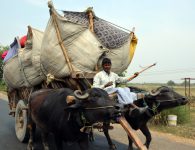Imphal, ‘the land of many villages’, is surrounded by bluish green mountains that guard the city as a fort. In fact, it is difficult to tell where the hills end and the plains begin, with tall pine, jack fruit and deodhar trees dotting the entire valley.
Historically, the city rose from the wreckage of the battle of Imphal, during the Second World War, and rebuilt itself with new vigor. The remains of the old Kangla Fort, ancient shrines and relics, the war monuments and timeworn houses stand in testimony to Imphal’s rich history.
This city also boasts of the oldest polo ground in the world where the game is still played. After all, modern polo, known locally as Sagol Kangjei, originated in Manipur. Also unique to Imphal is the Ima or mother market, where women run all the shops.
Kangla was the ancient capital of Manipur Kingdom. It is at the center of Imphal, the capital of Manipur. Kangla was also the seat of royal power and has religious as well as cultural significance for the Manipuris.
Manung Kangjeibung is the polo ground here, which was built during the time of Marjit who lived between 1813-91.
Shri Govindaji Temple was built in 1846 at Kangla by Nara Singh Maharaja.
Citadel is a fort-like structure deep at Kangla can be called the last defensive wall of Kangla Fort. The citadel was first built in 1611 AD, later it was rebuilt later in 1873 AD.
Manglen is a sacred site where the mortal remains of death kings were cremated to a flame called Manglen.
Hiyang Hiren are serpent-like boats with the head of Sangai is now displayed in a glass house. Boats were used by the Kings for boat race during festivals
Women’s market Khwairamband Bazaar, also known as the Ema Bazaar, or Nupi Keithel, literally means Mother’s Market or Women’s Market. The Ema Bazaar is one of the largest markets run by women in the country. Main items found here include handloom and handicraft products, like earthen pots, knives, shawls, puppets and all kinds of dried fish and vegetables. This is also one of the oldest markets with its rich tradition intact. Built in around 1533 AD, the amazing Ema Keithel was borne out of a desperate will to survive more than a well planned economical set up.






No comments